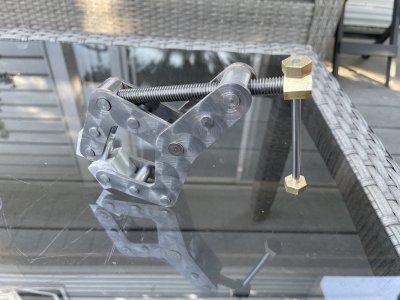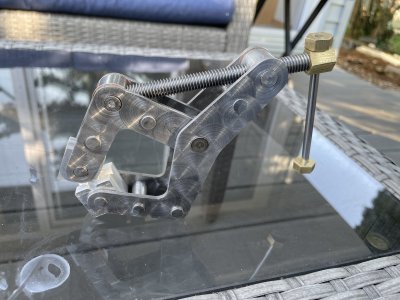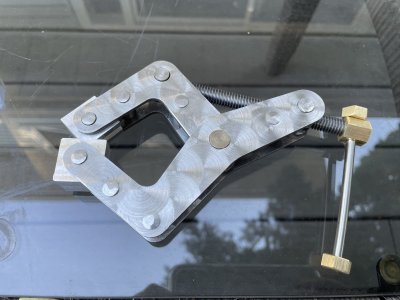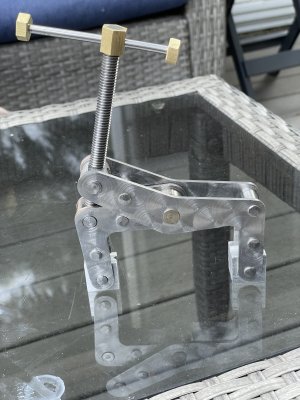A while back, I bought a kit for two 3" clamps from D.Gray Drafting & Design in Manitoba. I found his method of assembly not for me, mainly because of the complexity of holding everything together with machine bolts. No doubt that is a great way of building for some, and it does offer a degree of dis-assembly - should that ever become necessary. (Looks neat as well!) However, I used his excellent arms to good advantage in putting together the two clamps using the "peened pins" approach that had worked well for me in the past. I have no intention of ever taking these clamps apart, so the peening approach made sense to me. I also added one extra pin to both the short and long arms for added rigidity.
I also made and used some thin bronze washers, and the resulting action on the clamps has to be felt to be fully appreciated. Sooo Smooooth. Since I still have a quantity of those arms I mentioned in a previous post, it is now time to build a pair of 4.5" clamps from my own stock of laser-cut arms. I plan to also add the thin washers (each one is .008") to that build as well. I may get to building a pair of the smallest clamps as well. Those are 2.5" I think - they do not open quite as far as the D. Gray design.
A couple of things to mention... First - my attempt at holding these arms together with super-glue (as recommended) was good in theory - but the final product was out just a little. Second is that that super-glue residue is a real challenge to remove! I did my usual engine-machining to improve the look of the arms but even my carbide-particle pads hardly made any sort of dent in the residue. I tried my best to put these unsightly parts on the inside - but I know they are there...
The next build of the 4.5" clamps will have a change to the pivot pin on which the clamp arms rotate. The D. Gray design features a larger end shaft than my design, so, since it is pretty easy to use a step drill with some accuracy, I plan to open up the 5/16" opening on my arms to accommodate a thicker shaft. The planned 5/16" shaft should be plenty strong enough, but the larger size appeals to me. My thinking is that a step-drill will maintain the accuracy already present due to the laser-cut holes for all axles and pins - so I am hoping for no variance because of this change.
See the attached pictures for some details.
I also made and used some thin bronze washers, and the resulting action on the clamps has to be felt to be fully appreciated. Sooo Smooooth. Since I still have a quantity of those arms I mentioned in a previous post, it is now time to build a pair of 4.5" clamps from my own stock of laser-cut arms. I plan to also add the thin washers (each one is .008") to that build as well. I may get to building a pair of the smallest clamps as well. Those are 2.5" I think - they do not open quite as far as the D. Gray design.
A couple of things to mention... First - my attempt at holding these arms together with super-glue (as recommended) was good in theory - but the final product was out just a little. Second is that that super-glue residue is a real challenge to remove! I did my usual engine-machining to improve the look of the arms but even my carbide-particle pads hardly made any sort of dent in the residue. I tried my best to put these unsightly parts on the inside - but I know they are there...
The next build of the 4.5" clamps will have a change to the pivot pin on which the clamp arms rotate. The D. Gray design features a larger end shaft than my design, so, since it is pretty easy to use a step drill with some accuracy, I plan to open up the 5/16" opening on my arms to accommodate a thicker shaft. The planned 5/16" shaft should be plenty strong enough, but the larger size appeals to me. My thinking is that a step-drill will maintain the accuracy already present due to the laser-cut holes for all axles and pins - so I am hoping for no variance because of this change.
See the attached pictures for some details.




